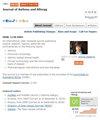过敏性鼻炎患者和非过敏性鼻炎患者的血液学、生化和血清过敏介质水平
IF 3.7
3区 医学
Q2 ALLERGY
引用次数: 0
摘要
背景:目的:本研究旨在比较过敏性鼻炎患者、非过敏性鼻炎(n-AR)患者、伴有下呼吸道症状的过敏性鼻炎(AR-SLRT)患者和健康对照组的生化指标和其他参数水平:研究设计:病例对照研究:分析三个研究组(AR 组(n = 22)、n-AR 组(n = 20)、AR-SLRT 组(n = 21)和对照组(n = 18)的血液样本,以确定总 IgE、特异性 IgE、包膜蛋白、垂体蛋白、维生素 D、甲状腺刺激素、甲状腺激素和甲状腺抗体的水平、维生素 D、促甲状腺激素 (TSH)、游离三碘甲状腺原氨酸 (Ft3)、游离甲状腺素 (Ft4)、抗甲状腺过氧化物酶 (TPO)、嗜酸性粒细胞阳离子蛋白 (ECP),以及白细胞计算公式和血象图。结果显示与对照组相比,AR 组和 n-AR 组的血细胞比容值明显升高(p< 0.05)。此外,AR 组和 AR-SLRT 组的嗜酸性粒细胞计数明显高于对照组(p< 0.05)。AR-SLRT 组的总 IgE 水平明显高于 AR 组、n-AR 组和对照组(p< 0.05)。AR 组的总 IgE 值高于对照组和 n-AR 组(p< 0.05)。各组间的 ECP、periostin、pendrin、Ft3、Ft4、TSH、抗-TPO 和维生素 D 值无显著差异(p> 0.05):所有研究组的 ECP、骨膜素、垂体素、Ft3、Ft4、促甲状腺激素、抗-TPO 和维生素 D 参数均无差异。AR阳性组和AR-SLRT阳性组的嗜酸性粒细胞计数高于对照组。AR-SLRT组的总IgE浓度高于其他组。本文章由计算机程序翻译,如有差异,请以英文原文为准。
Hematological, Biochemical, and Serum Levels of Allergic Mediators in Individuals with and without Allergic Rhinitis
Background: Allergic rhinitis (AR) is the most prevalent form of non-infectious rhinitis and is characterized by an immune response mediated by immunoglobulin E (IgE).
Aim: This study aims to compare the levels of biochemical markers and other parameters in individuals with AR, non-allergic rhinitis(n-AR), allergic rhinitis accompanied by symptoms of the lower respiratory tract(AR-SLRT), and healthy controls.
Study Design: Case control study.
Methods: Blood samples from the three study groups, AR (n = 22), n-AR (n=20), AR-SLRT group (n = 21), and the control group (n = 18), were analyzed to ascertain the levels of total IgE, specific IgE, periostin, pendrin, vitamin D, thyroid-stimulating hormone (TSH), free triiodothyronine (Ft3), free thyroxine (Ft4), anti-thyroid peroxidase (TPO), and eosinophilic cationic protein (ECP), as well as the leukocyte formula and hemogram.
Results: The AR and n-AR groups had significantly higher hematocrit values in comparison to the control group(p< 0.05). Further, eosinophil counts were significantly higher in the AR and AR-SLRT groups than in the control group(p< 0.05). Total IgE levels were significantly higher in the AR-SLRT group than in the AR, n-AR, and control groups (p< 0.05). The AR group had higher total IgE values compared to the control group and the n-AR group(p< 0.05). The values of ECP, periostin, pendrin, Ft3, Ft4, TSH, anti-TPO, and vitamin D did not differ significantly between the groups(p> 0.05).
Conclusion: All the investigated groups did not differ in ECP, periostin, pendrin, Ft3, Ft4, TSH, anti-TPO, or vitamin D parameters. The groups with positive AR and AR-SLRT had higher eosinophil counts than the control group. The group with AR-SLRT had higher total IgE concentrations than the other groups.
Aim: This study aims to compare the levels of biochemical markers and other parameters in individuals with AR, non-allergic rhinitis(n-AR), allergic rhinitis accompanied by symptoms of the lower respiratory tract(AR-SLRT), and healthy controls.
Study Design: Case control study.
Methods: Blood samples from the three study groups, AR (n = 22), n-AR (n=20), AR-SLRT group (n = 21), and the control group (n = 18), were analyzed to ascertain the levels of total IgE, specific IgE, periostin, pendrin, vitamin D, thyroid-stimulating hormone (TSH), free triiodothyronine (Ft3), free thyroxine (Ft4), anti-thyroid peroxidase (TPO), and eosinophilic cationic protein (ECP), as well as the leukocyte formula and hemogram.
Results: The AR and n-AR groups had significantly higher hematocrit values in comparison to the control group(p< 0.05). Further, eosinophil counts were significantly higher in the AR and AR-SLRT groups than in the control group(p< 0.05). Total IgE levels were significantly higher in the AR-SLRT group than in the AR, n-AR, and control groups (p< 0.05). The AR group had higher total IgE values compared to the control group and the n-AR group(p< 0.05). The values of ECP, periostin, pendrin, Ft3, Ft4, TSH, anti-TPO, and vitamin D did not differ significantly between the groups(p> 0.05).
Conclusion: All the investigated groups did not differ in ECP, periostin, pendrin, Ft3, Ft4, TSH, anti-TPO, or vitamin D parameters. The groups with positive AR and AR-SLRT had higher eosinophil counts than the control group. The group with AR-SLRT had higher total IgE concentrations than the other groups.
求助全文
通过发布文献求助,成功后即可免费获取论文全文。
去求助
来源期刊

Journal of Asthma and Allergy
Medicine-Immunology and Allergy
CiteScore
5.30
自引率
6.20%
发文量
185
审稿时长
16 weeks
期刊介绍:
An international, peer-reviewed journal publishing original research, reports, editorials and commentaries on the following topics: Asthma; Pulmonary physiology; Asthma related clinical health; Clinical immunology and the immunological basis of disease; Pharmacological interventions and new therapies.
Although the main focus of the journal will be to publish research and clinical results in humans, preclinical, animal and in vitro studies will be published where they shed light on disease processes and potential new therapies.
 求助内容:
求助内容: 应助结果提醒方式:
应助结果提醒方式:


